Analysis: New Military equipment and combat vehicles of Vietnamese Army
During the Viet Bac Exhibition Fair 2019 defense show that was held in Thai Nguyen from the 20 to 26 December 2019 for 75th foundation anniversary of the People's Army of Vietnam, Vietnamese ministry of defense has presented latest military equipment and combat vehicles which are now in service with the Vietnamese People’s Army (VPA).

Aerial view of Viet Bac Exhibition Fair 2019 defense show for the 75th foundation anniversary of the People's Army of Vietnam. (Picture source Twitter account IndoPacific News)
Armed forces of Vietnam have presented around 160 military equipment, including 75 weapon systems. Vietnamese Army has showcased the T-90S main battle tank (MBT), the BMP-2 infantry fighting vehicle (IFV), the ZSU-23-4 23 mm self-propelled anti-aircraft gun (SPAAG), the upgraded S-125-2TM Pechora-2TM stationary surface-to-air missile system, the BM-21 Grad 122 mm multiple rocket launch (MRL) system, the RV-02 mobile radar, the VUA-SC-3G unmanned aerial vehicle (UAV), and other systems. "These devices have been fitted with modern subsystems," said Soha.
A full range of wheeled and tracked combat vehicles were showcased including the T-90S MBT Main Battle Tank, a BMP-2 IFV Infantry Fighting Vehicle, a baseline BRDM-2 4x4 armored reconnaissance vehicle, and a ZSU-23-4 SPAAG. These armored vehicles were shown in their basic configurations with no upgrades.
As many other armies in the world, Vietnamese armed forces also use different types of UAVs including the VUA-SC-3G UAV designed to perform tactical reconnaissance missions, as well as the VUA-QL1 quadcopter that was also unveiled at this year’s Viet Bac defense show.
The Vietnamese military showcased its three new radars, namely, the RV-02 on a Belarusian-made MAZ (Minsk Automotive Plant) 6x6 heavy truck, the R-18M on an Ural-4320-family 6x6 truck and the VRS-2DM on a KAMAZ truck.
The VPA also showed its AJAS-1000 electronic warfare station, which was mounted on a KAMAZ truck.
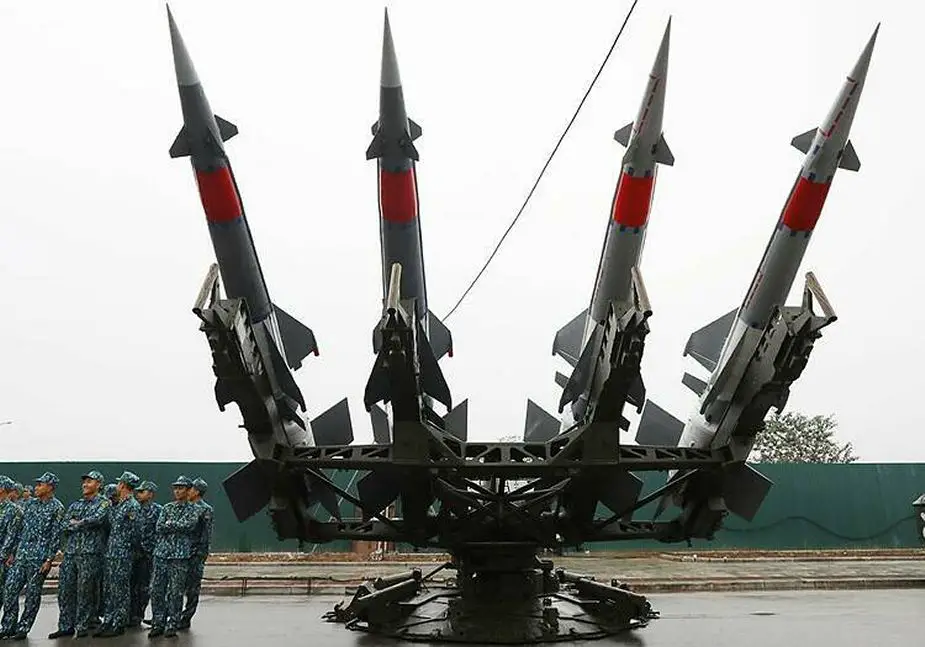
S-125-2TM "Pechora-2TM" (C12-2TM)
The S-125-2TM, also known as Pechora-2TM, is an upgraded version of S-125 / Pechora air defense missile system. It is able to destroy advanced, small-size aerial attack platforms flying at low altitudes. The S-125-2TM can also be deployed against ground and water-surface targets that are visible to radar.
The S-125-2TM missile system is capable of engaging targets in severe jamming environments and can operate independently or integrated into an Air Defence (AD) grouping. It is equipped with a GPS navigation system.
The S-125-2TM can simultaneously strike up to two targets at a speed of 900 m/s. The system has a maximum firing range of 35.4 km and a maximum cross range of 25 km. It can detect targets within the range of 100 km and engage targets at altitudes ranging from 0.02 km to 25 km. The kill probability of the missile system is 92%.
The emplacement / displacement time of the missile system is 25 minutes. The jamming resistance against active barrage jams is 2,700 W/MHz.
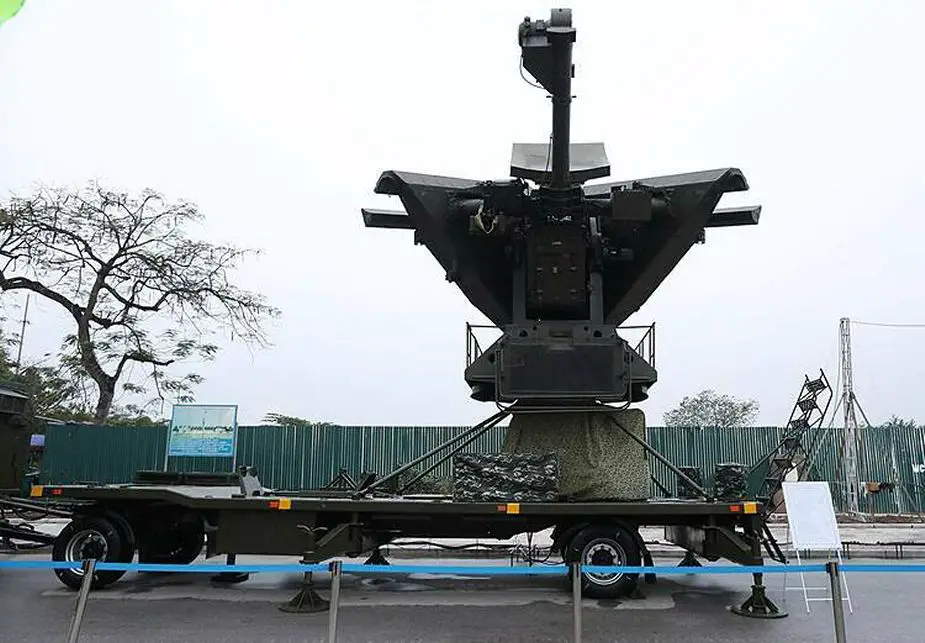
VRS-2DM radar control system
The VRS-2DM that was introduced in 2019, is a radar control system developed by Viettel, Vietnamese military’s telecommunication corporation, based on Soviet Union’s P-19 radar.
The VRS-2DM is a low-level, low-altitude, low-level 2D radar use to control the national airspace and provides information for anti-aircraft missile complexes.
In addition, the radar system can also provide information against aerial threats able to destroy flying targets, including low-flying targets, and airfields.

P-18M warning radar
The Warning Radar P18M also nicknamed Spoon Rest D is developed by Vietnam based on transferred technologies from Czech Republic.
The P-18M is a modernized version of the P-18 or 1RL131 Terek (also referred to by the NATO reporting name "Spoon Rest D" in the west) a 2D VHF radar developed and operated by the former Soviet Union. The P-18M radar has newly developed hardware. The frequency range was extended and the operational frequency is increased from 4 to 41, allowing the immediate automatic frequency tuning.
In the new radar station, the number of vehicles are reduced from 4 to 2: equipment vehicle, antenna vehicle. An aggregator is integrated in the equipment vehicle, which provides the radar’s smooth operation in case of power failure using an uninterruptible power supply.
The P-18M is a two-dimensional radar, which automatically defines the azimuth and range. The third parameter can be provided by a modern locator height-finder. The parameters of the transmitted signal and the parameters of the reflected, processed signal, the secondary signal display, which already takes into consideration the displacement and the speed of the target point, appears on ARM-0 and the remote ARM-1 workstation.
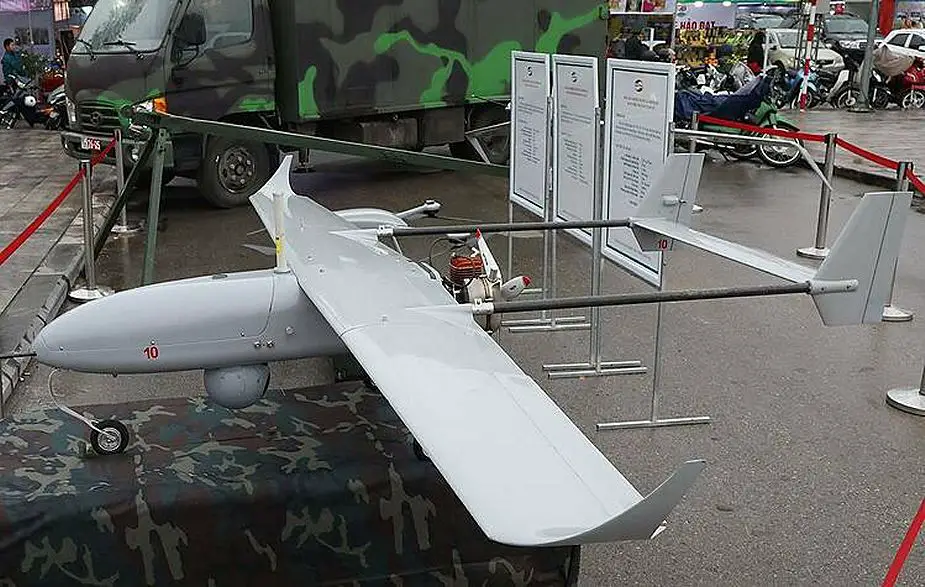
VUA-SC-3G drone
The VUA-SC-3G is a light surveillance drone produced in Vietnam by the Company Viettel. With a weight of 26 kg, it can fly at a maximum speed of 120 kph, operates during three hours at a maximum range of 50 km. Currently, the VUA-SC-3G is used to control the borders.
The VUA-SC-3G is used to perform patrol missions and monitoring border areas. It is equipped with an optical surveillance camera (EO Sensor) and a thermal imaging camera (IR Sensor). it can be used for reconnaissance missions during day and night and can transmit high-resolution image data to a command and control center.

VUA-QL1 drone
The VUA-QL1 is a quadcopter UAV (Unmanned Aerial Vehicle) developed by Vietnam National Defense Industry to perform reconnaissance missions.
The quadcopter is a multirotor helicopter that is lifted and propelled by four rotors. Quadcopters are classified as rotorcraft, as opposed to fixed-wing aircraft, because their lift is generated by a set of rotors (vertically oriented propellers).
The VUA-QL1 quadcopter can provide solutions such as real-time video with HD video capture and thermal imaging to your base station, as well as live data from sensor packages. Using custom miniaturized gimbal systems, the VUA-QL1 platform provides a stable, smooth video and IR imaging with two or three-axis options available.
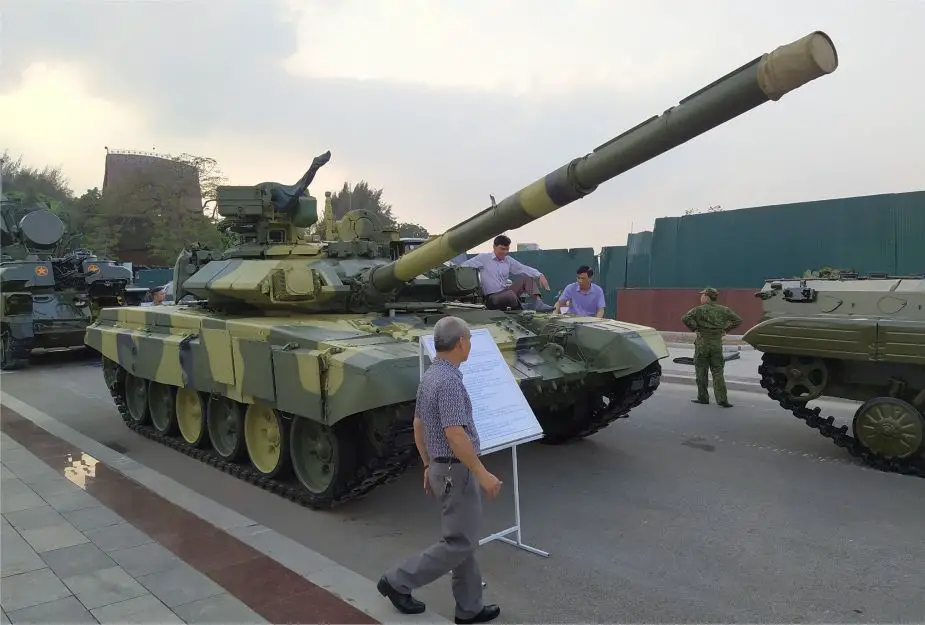
T-90S main battle tank
In July 2017 Vietnamese state-run news agencies confirmed that Hanoi had ordered 64 T-90Ss, including an undisclosed number of T-90SK command post variants. In March 2019, it was announced that Moscow has completed the delivery of 64 T-90S/SK main battle tanks (MBTs) to Vietnam, according to the Russian Federal Service for Military-Technical Cooperation.
The T-90S is an enhanced version of the Russian-made T-90 Main Battle Tank (MBT) to meet the operational requirements of countries in Asia.
Main armament of the T-90S MBT includes one 125 mm 2A46M smoothbore gun, stabilized in two axes and fitted with a thermal sleeve. The gun tube can be replaced without dismantling inside the turret. The T-90S is intended to engage tanks fitted with ERA (Explosive Reactive Armour) as well as low-flying air targets such as helicopters, at a range of up to 5 km.
The T-90S tank is protected by both conventional armour-plating and latest generation Kontakt-5 explosive reactive armour (ERA). The T-90S is fitted with the Shtora-1 defensive aids suite which is produced by Electronintorg of Russia.
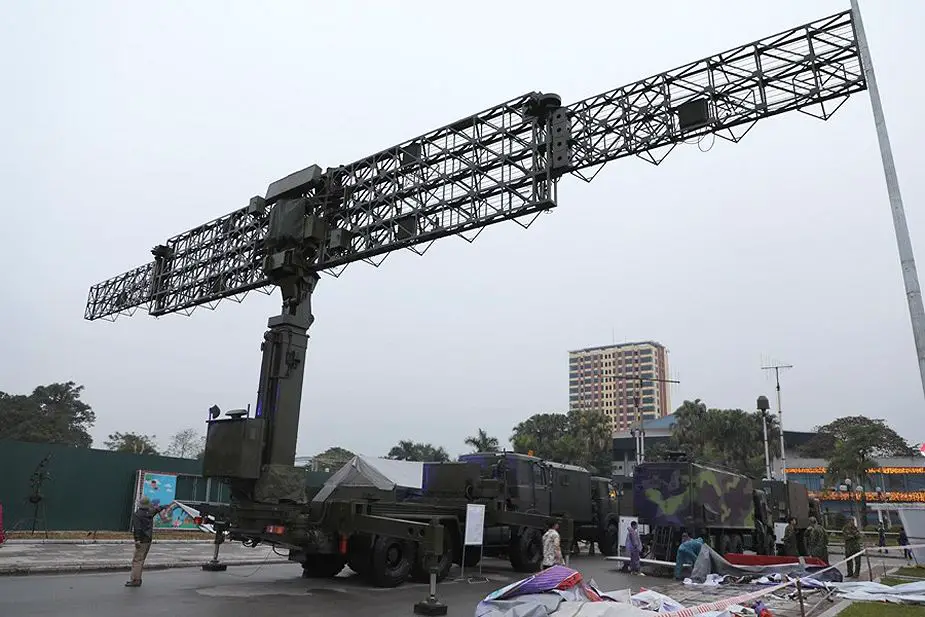
RV-02 Radar
The RV-02 is similar to the Belarusian KB-radar Vostok E, a medium-range anti stealth-aircraft radar. Vietnam has taken delivery of three RV-02 medium-range radars on April 2017.
The Vostok E is the export version of the highly mobile,Vostok D, a 6x6 truck-mounted 2D VHF radar design, using biquads as radiating elements with a fairly wide beamwidth, intended to improve frequency agility against earlier VHF radar designs. It uses 50 different transmitter frequencies around the center frequency of 175 MHz, which can be changed from pulse-to-pulse.
The Vostok E radar is designed for the detection of aerial platforms, measurement of their range, azimuth and range rate, automatic target tracking and classification,transmission of radar information into an integrated control system. It uses modern solid-state digital technologies. Vostok E can stow and deploy in as little as 6 minutes with a crew of 2 men.

RBB-01 UGV Unmanned Ground Vehicle
The RBB-01 is a tracked armed UGV Unmanned Ground Vehicle developed by the Defense Technology Institute, a sub-organization within the General Department of Defense Industry, Ministry of National Defense.
The RBB-01 is armed with a single weapon able to fire at a maximum range of 50 meters in a single shot mode or 2-3 round bursts.
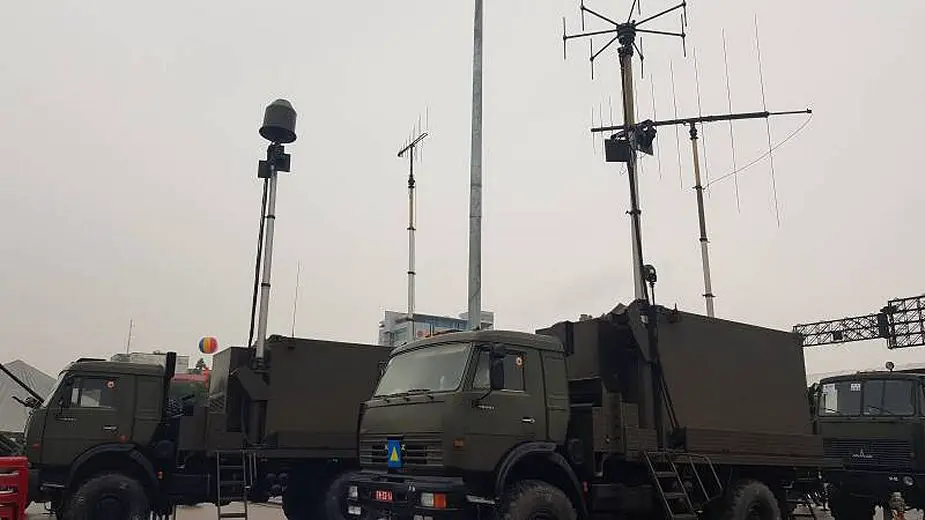
AJAS-1000 electronic jamming reconnaissance system
The AJAS-1000 is an electronic jamming reconnaissance manufactured by the German Company PLATH Gmbh, mounted on Russian-made 4x4 KamAZ-43253 truck chassis. The AJAS-1000 (AntiJam Antenna System) is an electronic warfare system specializing in tracking, zoning, reconnaissance and suppression on UHF/VHF digital shortwave (from 100 - 1,000 MHz) based on the principle source orientation.
This system is capable of suppressing radio communication equipment and transmitting shortwave digital data at close range. PLATH itself is a company with more than 60 years of experience in the field of communication, electronic warfare, especially jamming and repressive equipment.
The AJAS-1000 has a modular design that makes it easy to mount on a variety of vehicles. At the request of Vietnam, PLATH has integrated AJAS-1000 on Russian-made 4x4 KamAZ-43253 truck chassis. For the AJAS-1000, the use of the KamAZ-43253 chassis helps to optimize the complex's combat capability, when all equipment including control stations, antennas and transmitters are put together on one frame. single roar.
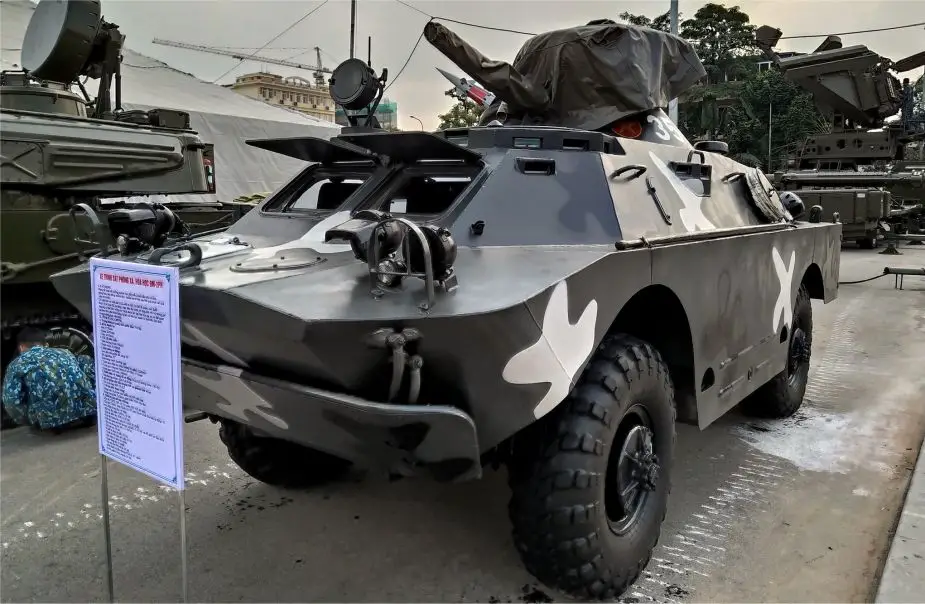
BRDM-2 4x4 reconnaissance armored vehicle
The BRDM-2 is a Soviet-made 4x4 light armoured vehicle designed by V K Rubtsov of the Dedkov OKB in the early 1960s. This vehicle entered in service with Soviet Army in 1962 with first production in 1963 and was showed for the first time to the public in 1966. The BRDM-2 is mainly used as reconnaissance armoured vehicle and still in service with the Russian armed forces and by many other countries all over the world.
The BRDM-2 is equipped with a single-man turret mounted in the centre of the vehicle. The turret is armed with 14.5mm KPVT heavy machine gun and a coaxial 7.62 PKT machine gun on the right side.
The all-welded steel armour hull of the BRDM-2 provides the crew with protection from small arms fire 7.62mm caliber and shell splinters. The driver is seated at the front of the hull on the left with the vehicle commander to his right. Both are provided with a bulletproof windscreen to their front, which is covered by an armoured shutter, hinged at the top, when the vehicle is in combat areas.

ZSU-23-4 anti-aircraft self-propelled cannon
The ZSU-23-4 "Shilka" is a Russian lightly armoured, self-propelled, radar guided anti-aircraft weapon system (SPAAG). The ZSU-23-4 Shilka was developed in the early 1960's and was first seen in public during a parade in Moscow in November 1965.
The main armament is composed with four AZP-23 23 mm canons with an elevation of +85° to - 4°, and 360° turret traverse. The 23 mm canon is gas operated with a vertically moving breech-block locking system which drops to unlock, and has a cyclic rate of fire of 800 to 1000 rounds per minute per barrel. The ZSU-23-4 Shilka can engage targets using only one or two of the four canons.
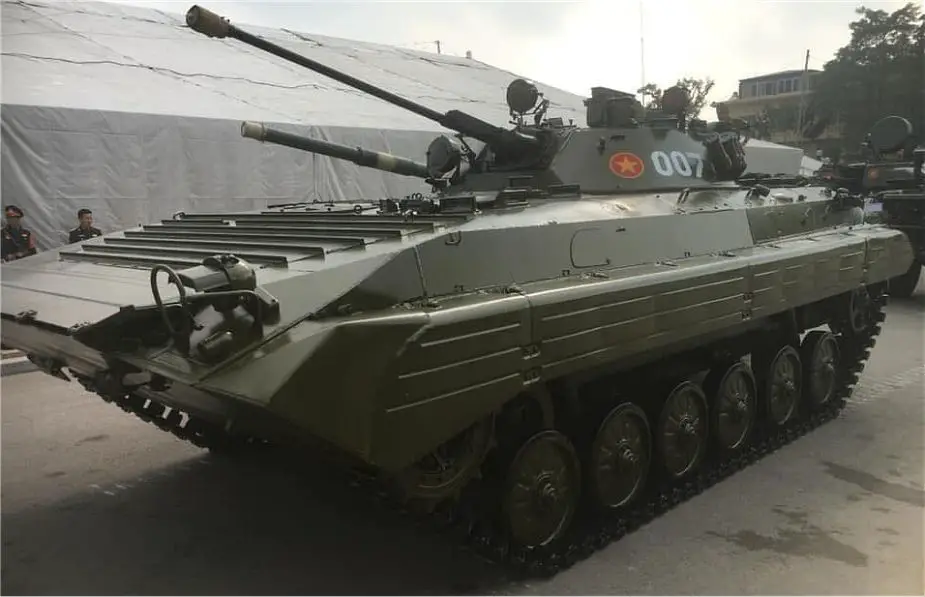
BMP-2 IFV tracked Infantry Fighting Vehicle
The BMP-2 is tracked infantry armoured fighting vehicle designed and manufactured by the Russian defence industry. This vehicle was based on the Russian-made BMP-1. The BMP-2 enters in service with the Russian armed forces in 1980, and the vehicle was seen for the first time in public during a military parade on the Red Square in Moscow, in November 1982.
The BMP-2 is fitted with a two-man turret armed with a stabilized 30 mm cannon 2A42 and a 7.62 mm PKT coaxial machine gun mounted to the left of the main armament with 2,000 rounds. A bank of three smoke grenade dischargers is mounted on each side of the turret. Mounted on the turret roof between the gunner's and commander's hatches is a launcher for an AT-4 SPIGOT or AT-5 SPANDREL ATGM (Anti-Tank Guided Missile) which has a maximum range of 4,000m. The 2A42 two-axis stabilized automatic cannon; the 7.62-mm PKT coaxial machine gun and the antitank guided weapon launcher enable the crew to hit different targets, including tanks and combat helicopters.

STV-275 & STV-380 assault rifles
Two new assault rifles manufactured by Vietnamese firearms Company were unveiled during the Viet Bac Exhibition Fair 2019, the STV-275 & STV-380. Both seems to have the same design as the Israeli assault rifle Galil but some parts are very similar to the design of Russian-made AK-74M as the handguards.


























